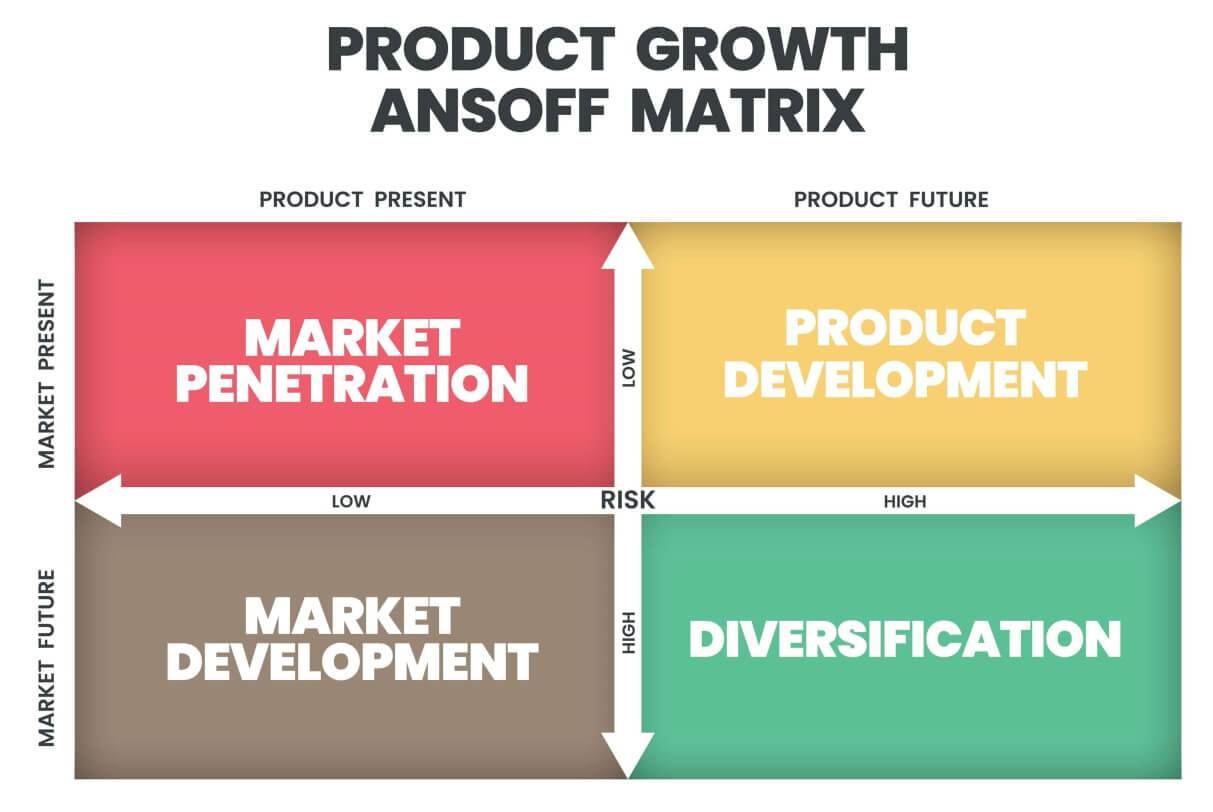Do you want to grow your company? Due to personal ambition, because an opportunity has presented itself, or simply to increase your turnover? Whatever your motivation, there are various ways to grow a company.
The Ansoff model
These ways are clearly presented in the Ansoff model, a strategic tool used during the development of a growth strategy. It is a good basis for considering the strategic development of your company.
The Ansoff growth matrix is comprised of two axes
- Products:
Which products do you currently offer, and which new products would you like to offer in the future? - The market:
Which markets do you currently serve, and which markets would you like to serve in the future?

The four growth strategies
Four types of growth strategies are proposed on this basis. The four main growth strategies are as follows:
-
Market penetration
The aim of this strategy is to increase sales of existing products or services on existing markets, and thus to increase your market share. To do this, you can attract customers away from your competitors and/or make sure that your own customers buy your existing products or services more often. This can be accomplished by a price decrease, an increase in promotion and distribution support; the acquisition of a rival in the same market or modest product refinements.
-
Market development
This means increasing sales of existing products or services on previously unexplored markets. Market expansion involves an analysis of the way in which a company's existing offer can be sold on new markets, or how to grow the existing market. This can be accomplished by different customer segments ; industrial buyers for a good that was previously sold only to the households; New areas or regions about of the country ; Foreign markets
-
Product development
The objective is to launch new products or services on existing markets. Product development may be used to extend the offer proposed to current customers with the aim of increasing their turnover. These products may be obtained by: Investment in research and development of additional products; Acquisition of rights to produce someone else's product; Buying in the product and "branding" it; Joint development with ownership of another company who need access to the firm's distribution channels or brands.
-
Diversification
This means launching new products or services on previously unexplored markets. Diversification is the riskiest strategy. It involves the marketing, by the company, of completely new products and services on a completely unknown market.
Diversification may be divided into further categories:-
Horizontal diversification
This involves the purchase or development of new products by the company, with the aim of selling them to existing customer groups. These new products are often technologically or commercially unrelated to current products but that may appeal to current customers. For example, a company that was making notebooks earlier may also enter the pen market with its new product.
-
Vertical diversification
The company enters the sector of its suppliers or of its customers.For example, if you have a company that does reconstruction of houses and offices and you start selling paints and other construction materials for use in this business.
-
Concentric diversification
Concentric diversification involves the development of a new line of products or services with technical and/or commercial similarities to an existing range of products. This type of diversification is often used by small producers of consumer goods, e.g. a bakery starts producing pastries or dough products.
-
Conglomerate diversification
Is moving to new products or services that have no technological or commercial relation with current products, equipment, distribution channels, but which may appeal to new groups of customers. The major motive behind this kind of diversification is the high return on investments in the new industry. It is often used by large companies looking for ways to balance their cyclical portfolio with their non-cyclical portfolio.
-
Conclusion
Based on the strategies used and its ambitions, a company can choose one of these four strategies. This choice especially depends on the approach of a company's product/market and the latter's taste for risk.